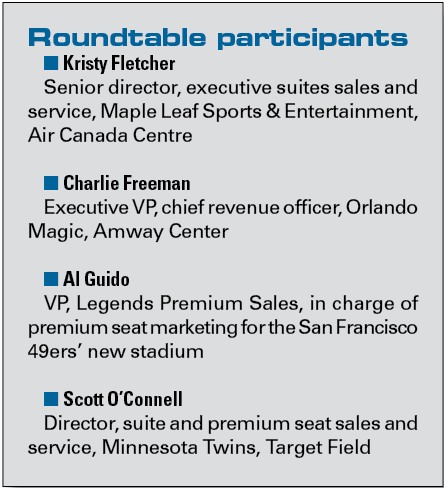Premium seating continues to be a sales challenge as buyers give more scrutiny to their deals, the amenities they receive, and the return on their investment. To get a clearer picture of the premium landscape, SportsBusiness Journal facilities writer Don Muret asked four executives in the trenches to share their experiences. In a recent teleconference, they outlined how they have adapted to changing demands in their markets and how they’ve packaged perks and inventory to close the deal.
Q: Provide a breakdown of the premium seat mix in your buildings.
AL GUIDO, LEGENDS PREMIUM SALES: For the new 49ers stadium, we have three types of suites: 22 owners suites, all-inclusive from a food and beverage standpoint and [they include] all events. Those are sold out. All 20-year terms, $500,000 annually. Then we have our executive suites called the Tower Suites, around 108 total, and we’re 70 percent sold through on those. The Trophy Club Suites are our end zone suite product. It’s technically the same as an executive suite except it has a communal club space and all-inclusive food and beverage. From a club seat standpoint,
we have two. Legacy Seats are field clubs, similar to the Cowboys and Jets and Giants as it relates to having access down on the field. Those are 75 percent sold. Then we have traditional club seats, about 8,000, also 75 percent sold.
KRISTY FLETCHER, MAPLE LEAF SPORTS & ENTERTAINMENT: We have 142 suites. That number is broken down into 28 Platinum Suites — other venues might call them bunker suites. They have 10 tickets within the arena that go along with them. We have a product called Chairman’s Suites, where we converted 12 Platinum Suites into a large club, about 4,000 square feet, that accommodates 120 guests. We have 24 Theater Suites as well as 24 Loge Suites. They are comparable to our 200-level suites but in a less desirable location. We have 65 Executive Suites around the ring of the venue with 12 seats, with the ability to buy an additional eight tickets. The Chairman’s Suites are sold out. We have one open suite in our Executive Suite ring and are sitting on three open suites between our loge, theater and platinum. Four open suites out of 142. Our club seats are sold out.
CHARLIE FREEMAN, ORLANDO MAGIC: A lot of our agreements are three-, five-, seven- and 10-year deals, so being that we’re entering year three, we are pretty much sold through, 90 to 95 percent. We’ve got our Founders Suite Level and Presidents Suite Level, 32 on Founders, 28 on the Presidents. Sixty-eight loge boxes. Our Legends Suite is all-inclusive. I hate to say the word co-op suite, but it’s the ability to buy two, four, six tickets at a time. There are 150 tickets in each one of those super boxes. Then we have our courtside seats in our first five rows which have access to the Mercedes-Benz Lounge. All total, about 800 seats.
SCOTT O’CONNELL, MINNESOTA TWINS: We’re entering our fourth season at Target Field. There are 54 annual suites with 52 long-term contracts. Two of those we hold back for 10-game packages, a feeder system for annual suite holders. The vast majority of our suites are four-, seven- and 10-year deals, so I’ve got 19 suites out of 54 coming up for renewal. Behind home plate, the Champions Club consists of 413 seats. We’re through the renewal process on that, year to year. I’ve had eight seats that did not get renewed from last year. … I’ve got a waiting list of 57 names of people looking to get into the Champions Club, so it’s not going to be too difficult to find homes for those eight seats. Our Legends Club, which is a 3,000-seat wood-back chair location above the infield — we’re seeing a little bit more attrition in that area. I’ve got 142 seats available and I’m still looking at probably another 100 accounts yet to pull the trigger on coming back next year.
Q: How have these premium seat products changed over the years to meet market demand? Are there trends specific to your market?
FLETCHER: Right around the time of the recession, we had about $20 million coming up for renewal, our largest year ever. That’s when we sat back to look at our product mix. The first thing we did was take away bunker suites. At one time, we had 40. The perception of these suites [by customers] was no view of the ice, a little bit smaller, a little bit darker and I think they were losing flavor a little bit. So we took 12 bunkers and converted them into a very beautiful, almost super-premium space. At the time, it went against maybe what popular thought would be in that super premium
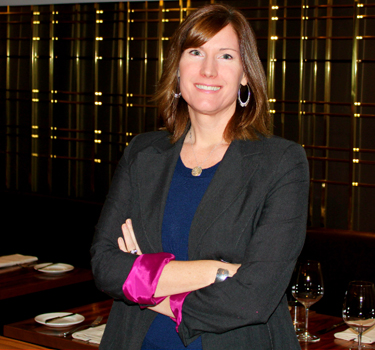 |
Kristy Fletcher
Photo by: MLSE |
was not going to sell coming out of a recession. But we actually found in this market that there was a place for super premium. It was [still] underneath [the seating bowl], it wasn’t as conspicuous, and there was still a market for it.
We sold out of that space … with two-year terms … and charged $100,000 for a pair for all events in the building. We actually did just sell them out again when the majority of those came up for renewal this past year. We’ve been very happy with that product. It’s allowed people to enter the super premium market without having to buy a full suite. You could buy two, four, six tickets, whatever worked for your business. It was a great networking tool; we saw huge benefit in that. Someone who bought in owns a Porsche dealership and has sold three or four cars to other members. It’s allowed us to really get to know the clients well, understand what their business needs are and bring like-minded clients together.
And lastly, instead of cutting back on our sales force and service, we added staff at a time when I think a lot of people were cutting back. In the long run, it took us from having at our peak 18 unsold suites to four.
O’CONNELL: We made some adjustments on the fly as the ballpark was built. We initially had plans to put in 60 annual suites, but as the recession kicked in, in the midst of our selling process, we decided to turn a few annual suites into party suites. We took the six suites furthest down the third-base line and turned them into two 50-person Skyline Suites with a view of downtown Minneapolis. They have been a great vehicle for us because we have nothing [else] of that size to handle a large group. We have a pocket door between the two which can make it accessible for up to 100 people. I think we were smart enough to recognize when the recession hit that this was something that we were going to end up doing eventually, let’s do it now and take care of our needs initially. We have the MLB All-Star Game [in 2014], something we had an inkling about for quite some time. So that’s why we went to market with a four-year lease instead of three years. We timed it so these leases would expire at the time of the All-Star Game. We also have the Vikings to contend with as their new facility is coming online. They will come to market with 100 to 150 suites, so a lot of what happens [with us] will depend on how good of a product we have got on the field.
FREEMAN: We do a lot of research and focus groups and have met with all of our premium seat holders. The things we’re hearing that are very successful is that they like our all-inclusive products. In particular, the Legends Suite and our courtside seats. The all-inclusive is something that people like, that turnkey approach where they can give tickets to clients. So we’re looking at that potentially for our loge product and other spaces in the building. We continue to try to focus on ways we can enhance, whether it’s amenities, food offerings. As of right now, we’re in that due diligence phase to try and understand what the market may dictate in the future.
GUIDO: I think the NFL in general has seen a shift to yard-line club seats. We’ve seen a shift where the premium product on the 100 level and the mezzanine level becomes a price reduction for a club seat. We do our best to limit end zone inventory from a premium standpoint. It really just doesn’t have a lot of cachet, so instead of creating multiple products, we went with a less-is-more approach with just suites and clubs. You have to take a hard look at value proposition. … We didn’t want to compete with ourselves by having a four- or eight-person loge box go up against a 16-person suite. We just figured, let’s take a look at our 16-person suite price and determine what the value proposition will be, because the objection on number of people in a suite wasn’t really something we were hearing that much.
Another concept starting to grow legs is communal spaces for suite owners, an extension of a tailgate in a premium space. For us, 22 suites with a 22,000-square-foot club, with all-inclusive food and beverage, becomes a who’s who of the marketplace.
Q: What are your customers asking for that may be different than when you first took those products to market, everything from amenities to experiences? What are they asking you for before they sign on the dotted line?
O’CONNELL: As we get into this process, some of the things we’re trying to come forward with, [for example], each suite received two parking spots. We’re now going to renovate that into more of a valet parking spot associated with our
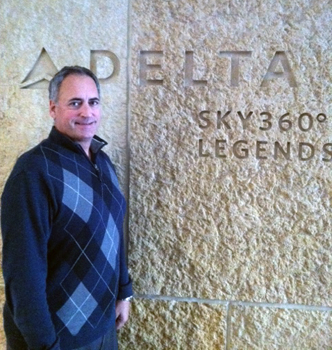 |
Scott O'Connell
Photo by: Minnesota Twins |
Champions Club and one parking spot in the neighboring ramp. More of a VIP access point for our suite holders. We’re going to freeze the price escalator for a year if they renew for four years, and for two years if they renew for seven years. We have in each suite a drink rail on the window for the four-year contract [with] four seats, and are going to [include those] for free for the duration of their deal. And obviously the All-Star Game is going to be a hell of a leverage for us.
FREEMAN: We do some similar things on the event side to stay engaged. We have our summer league every year where we invite folks into the arena. We also do a fantasy camp for all of our suite holders, a competition between our Founders Level and our Presidents Level. We have our coaches and players out there. We also have a premium golf tournament. The other thing we’re exploring is our B-to-B platform and how we can help our clients, both our corporate partners, as well as our premium customers, together to help create business opportunities.
FLETCHER: In Toronto, we just came off another $20 million renewal. We have our standard package with a trip to the Masters. There is enough exclusivity that it will push a renewal. A lot of things we were hearing over the past 12 months is a lot of our suite holders are looking for measurement tools. So, what can we do to help them track their inventory when they’re getting 150 events a year and you have one suite administrator trying to manage all the inventory? We implemented Spotlight [software management] this year. Another thing we hear a lot is they really do want the VIP exclusive access to our athletes, to our coaches, anything really behind the scenes that we can offer them or their clients.
Our single-most successful renewal tool is the Adopt-a-Suite program. We have become our own secondary ticket market. We have 150 events in our building, often too many for suite holders. We take back their unused inventory and try to resell it for them. … So when it comes time to renew their suites and we’re putting a fairly large number in front of them, we can say, yes, however, we were able to help subsidize whatever portion it is. It’s not a revenue driver for us. We’ll take a 15 percent cut of the fee and give 85 percent to the suite holders. If I can keep five to 10 suite holders, it’s really invaluable to us.
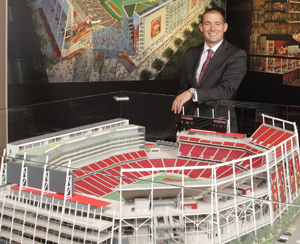 |
Al Guido
Photo by: San Francisco 49ers |
GUIDO: We have spent a ton of time with our suite owners on ROI and how they manage their suite inventory. I’m sure everybody has a suite owner who does a really good job of having a person internally manage that suite; they’re responsible for sending the tickets out, the sales reps who are using those suite tickets need to come to that person, there’s an invitation system. We did the U.S. Open this year in San Francisco for our suite owners and I can tell you that the first-class nature in which the U.S. Open went to provide us with materials to invite our suite guests, made it a lot easier for us to manage five days worth of 50 tickets each. What was overwhelming at the beginning, because they provided so many tools for us to use, wasn’t really that overwhelming.
Q: What do you think the suite of the future will look like 10 to 20 years from now?
FLETCHER: It’s going to incorporate a lot more technology than what your average suite is now, more fan focused. I think we’d all love to get to a point where you have one application that would allow your suite holder to order food, contact their hostess or purchase additional tickets for an upcoming game. We invested in more boardroom space to use their suite as more of an extension of their office.
FREEMAN: I think what’s important for all the buildings is that you remain flexible based on demand. So if the
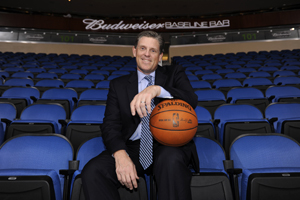 |
Charlie Freeman
Photo by: Orlando Magic |
demand for loges increases, can your building shift to put more loges in it? If there is a demand for more club seats down low, you have the ability to do that. This is something we looked at in design so your building can change as market conditions change. Premium products will continue to go in phases and you need to make sure your building, from an infrastructure perspective, is set up to be able to handle those demand changes.
O’CONNELL: You’re going to find suite owners looking for more of a return on their investment. That’s nothing new, but I think as we move forward into the future, it is paramount part to owning a suite. They’re going to have more of a marketing scene in their suites. I’ve got [high-end countertop maker] Cambria in this facility that utilizes their suite on a pretty regular basis during the offseason and during the regular season to use it as an opportunity to [sell] their wares. I think you’re going to find it’s not just a box for a game; it’s an extension of their business and they need to use it more for that than just entertaining.
GUIDO: It’s so important when you’re designing a new building to think about the future of your premium areas and what your sell-through rates are as you’re going through the process of selling the building. As Charlie said, we have spent a ton of time on areas that could easily convert to club spaces. The other thing, location has become extremely important from a suite perspective. People like being outdoors and closer to the field of play. The last part, we are in a software world now. Can I run my tablet? Can I get replays? Can I order food? Can I change the lighting? Can I run PowerPoints off my suite? What type of flexibility do you have in technology? That to me is the future of the premium seat world.


